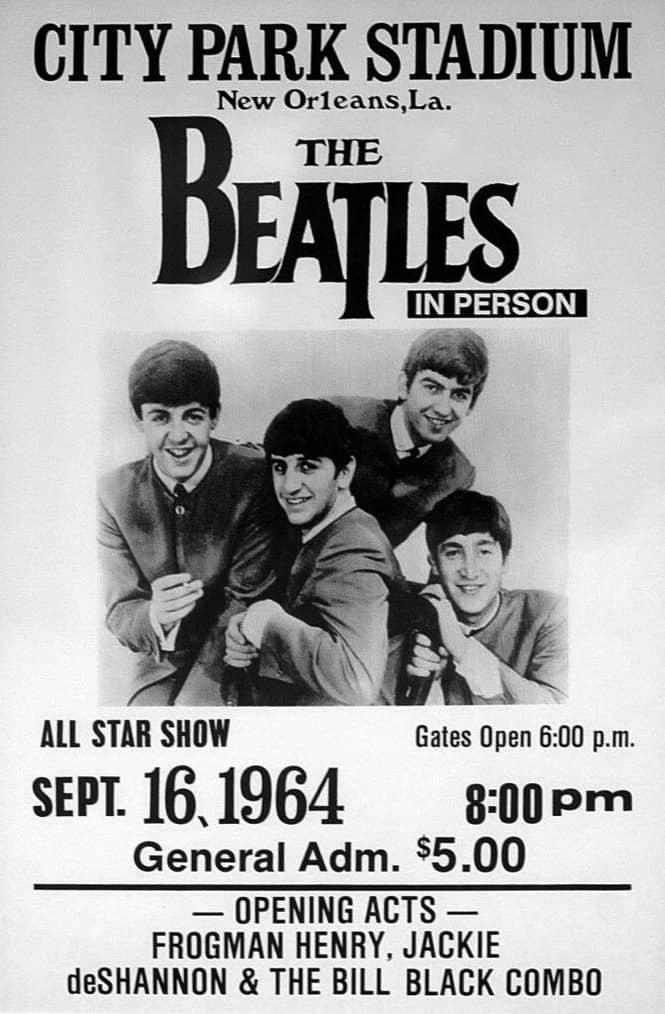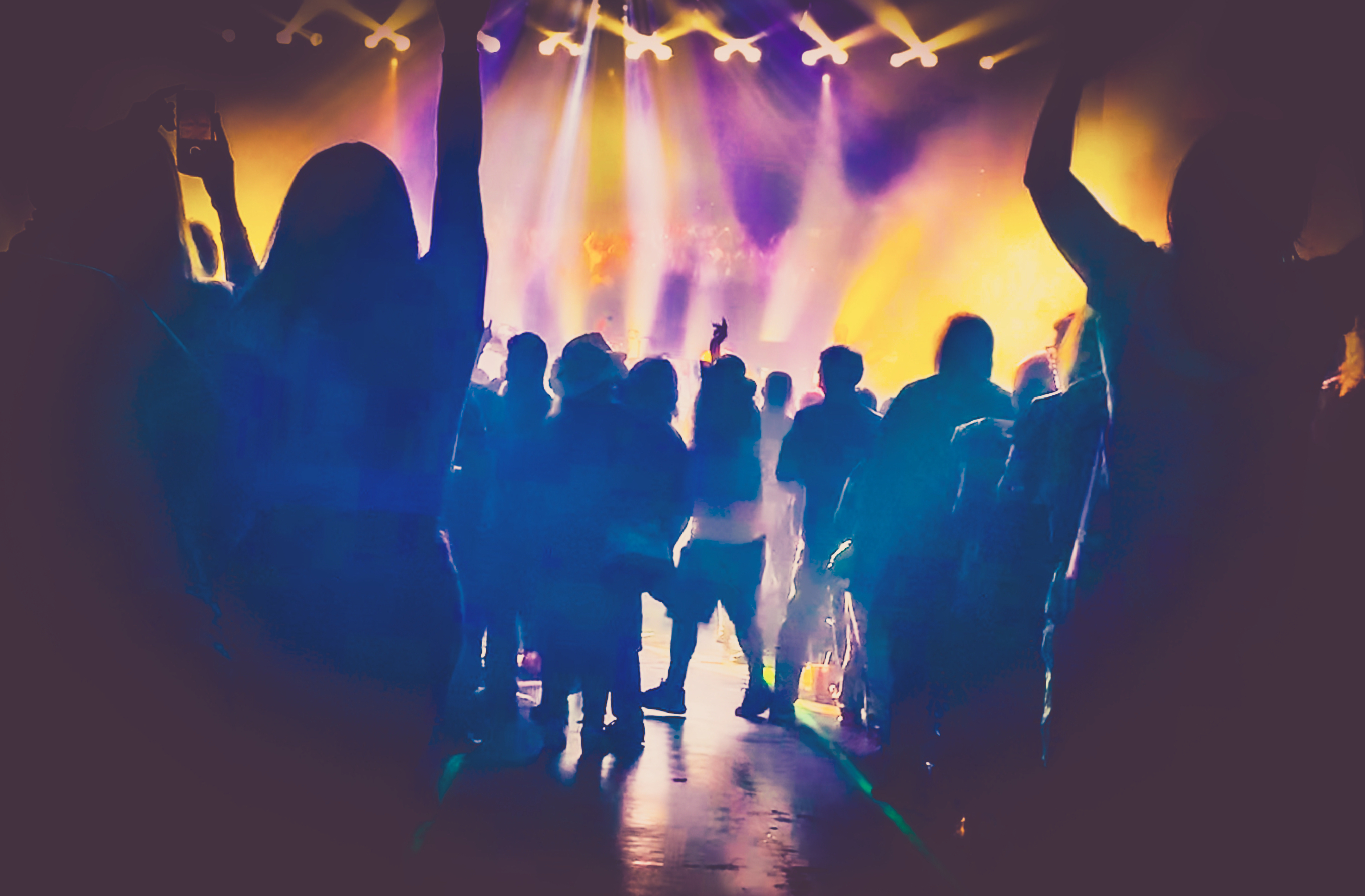Paul McCartney was 22 years old the first and only time he and his mates from Liverpool played a gig in New Orleans. They spent less than 24 hours in town, and it was pure pandemonium from the moment they landed. A helicopter was supposed to have met them at Lakefront Airport in order to whisk them away to their hotel, but mechanical issues kept it grounded. Instead, organizers sent over a caravan of limousines, but unfortunately, they were dispatched to the wrong airport.
Their police escort somehow got separated from them during the drive to the hotel, and the word got out to fans: The Fab Four were staying at the Congress Inn on Chef Menteur Highway. In the afternoon, New Orleans Mayor Victor Schiro showed up to give them all ceremonial keys to the city and present them with a proclamation declaring Sept. 16th, 1964 as “Beatles Day.” Before the show, the band met Fats Domino backstage; meeting him was the one and only request they had made.
(Decades later, when Fats Domino’s home in the Lower Ninth Ward was destroyed by the Federal Flood in the aftermath of Hurricane Katrina, Paul McCartney helped pay to restore one of Domino’s prized Steinway grand pianos. Today, the piano belongs to the New Orleans Jazz Museum in the Old Mint Building.)

Domino, who passed away at the age of 89 in late October 2017, was, at the time, one of the most famous musicians on the planet, but while he may have not realized it at the time, 1964 would mark the end of his decade-long dominance on the billboard charts. America was in the very beginning of the throes of the British Invasion.

That night, 12,000 screaming fans packed City Park Stadium to hear the Beatles play a 12-song setlist. They were so loud that recordings of the show are essentially worthless. 200 kids fainted; one girl broke her arm. The local police were aggressive and unamused by Beatlemania. All told, the band was on stage for less than a half an hour. They’d hoped to spend the next day casually touring the Birthplace of Jazz, but they had picked up a gig in Kansas City that changed their plans.
Last Thursday, in front of a sold-out crowd of nearly 18,000, Paul McCartney, now a 76-year-old billionaire who became Sir Paul more than two decades ago after being knighted by Queen Elizabeth II, spent nearly three hours on the stage of the Smoothie King Arena in New Orleans, playing 38 songs from his catalogue, most of which now rank as global classics.
When he was here as a 22-year-old, the tickets were $5. A day before Thursday’s show, floor tickets were listed online for as much as $3,000 a pop. Fortunately, I didn’t have to cough up nearly that, and because I use a wheelchair for events like these and because the security on Thursday was far more generous than the cops who worked the Beatles show in 1964, I ended up in the dead center of the floor, with a largely unobstructed view of the stage.
Funny enough, the only time I couldn’t see the stage was during the obligatory performance of “Hey Jude,” when actor Harry Shearer and his wife, singer-songwriter Judith Owen, stepped into the aisle and held each other close as they sang along. Thankfully, no one bothered them, though the couple who sat next to me, a teenage girl and her mother, were both thrilled when I discreetly pointed out that the voice of half of the characters on “The Simpsons” (among other things) was in front of us. I’d met Shearer several years ago when he delivered a keynote speech at Rising Tide, a conference of Louisiana and New Orleans-based bloggers and activists that had convened every year in the decade after Hurricane Katrina. I don’t know him personally, but I have always admired his advocacy on behalf of his adopted hometown.

There aren’t too many benefits to being disabled, but the ADA section at concerts is definitely one of them. It’s the only reason that I’ve been fortunate enough to have seen hundreds of concerts and even been able to attend nearly a dozen music festivals throughout the past twenty years. But until Thursday, I’d never before seen Macca in person, and perhaps like many others in attendance, I imagined the show would likely be the last chance I’d ever get to see him in New Orleans. After all, he is 76, nearly 77, and it’s not like he’s touring because he needs the money.

But if you hadn’t known otherwise, you would be forgiven for thinking McCartney was a man twenty years younger. Sure, he has finally allowed his hair to turn gray, and sure, he no longer has the same youthful voice he did when he recorded “When I’m Sixty-Four.” But there aren’t many musicians in the world who can play seven different instruments over the course of a 38-song, nearly three-hour-long set, and arguably, the only other septuagenarian rock star as high-octane as McCartney is his 75-year-old rival, Sir Mick Jagger. (The Rolling Stones announced today that they will return to New Orleans for a show at the Superdome on July 14th, after being forced to cancel their planned performance at this year’s JazzFest).
I’ve never really understood the ideological divisions between fans of the Stones and fans of the Beatles. Of course, I belong to a different generation, barely a millennial and born two years after John Lennon was assassinated. Whenever I’ve been asked to chose between the two bands, I dismiss the question as a false choice, which it is. The Beatles may have first become famous for their up-tempo pop songs about teenage love, but I imagine that, like me, most fans prefer their later work, which is imbued with profound meditations on loss and religion and heavily influenced by their own experiences with psychedelics and Eastern mysticism.
They may have been a pop sensation when they arrived in New Orleans in 1964, but as we know now, by the next year, with the debut of Rubber Soul, John Lennon and Paul McCartney began a five-year streak that forever cemented their global influence and set a bar for songwriting brilliance that has never again been equaled. (George Harrison was in his own right a genius composer, but as songwriters, the duo of Lennon-McCartney was the core of the band’s transformation).

McCartney’s show on Thursday was the first part of the U.S. leg of “Freshen Up,” his 2019 world tour, and perhaps because he had taken a month-long break after completing a string of shows in South America, his voice was, for the most part, surprisingly strong. He had full control of his falsetto, and he punctuated his rock songs with on-key screams.
He also regaled the crowd with small asides about his career and his personal life (both his wife and his daughter Mary were in attendance). For most fans, these stories are already well-known, like the time he watched Jimi Hendrix cover “Sgt. Pepper’s Lonely Hearts Club Band,” with the help of Eric Clapton.

To me, two moments particularly stuck out: While introducing “Blackbird” as a song inspired by the “little girls in Alabama,” a reference to the four children killed in 1963 in Birmingham during the 16th Street Baptist Church bombing, he spoke about meeting people across the world who have told them they learned how to play the guitar because of the song.
“How many of you know how to play ‘Blackbird?’” McCartney asked the audience. Thousands cheered back.
The other stand-out moment, at least to me, was when he picked up the ukulele and played a stripped-down version of “Something,” which he dedicated to George Harrison. “Cheer for Georgie,” he asked.
The place went wild.
Macca clearly has a deep affection for New Orleans. He’d camped out in town for a few days before Thursday’s show. He became much more familiar with the Big Easy than any of his fellow Beatles. In recent years, he’s been spotted at art galleries in the French Quarter, taking in a Jeremy Davenport show at the Ritz-Carlton, schmoozing at the Polo Club in the Windsor Court hotel, and, most famously, serenading streetcar passengers.

For a brief moment in 1975, five years after the Beatles broke up, it looked like a distinct possibility that New Orleans would be the setting of the band’s reunion.
For five weeks, McCartney and his band Wings recorded their album “Venus and Mars” at Sea-Saint Studios in New Orleans, collaborating with Allen Toussaint. But before they arrived, McCartney and his late wife Linda had dinner with John Lennon and May Pang, Lennon’s then-girlfriend. After dinner, McCartney invited Lennon to join him in New Orleans; there was no pressure to record anything, of course, but it seemed inevitable that’s what would happen.

Unfortunately, at the last minute, Lennon canceled, and the reunion never occurred. It’s a shame.
If Thursday night’s show proved one thing, it’s that McCartney is still capable of evoking the same magic that launched him into the stratosphere. He shone brightly in the Crescent City, and hopefully, the next time he is in town, he can be convinced to play again at the Superdome instead. He’s already well-acquainted with the Dome; he stopped there during his 1993 world tour and again in 2002, when he opened up Super Bowl XXXVI.
If there is any criticism to be found about his show on Thursday, it’s that the venue was too small for the kind of party the city should throw for Sir Paul.
